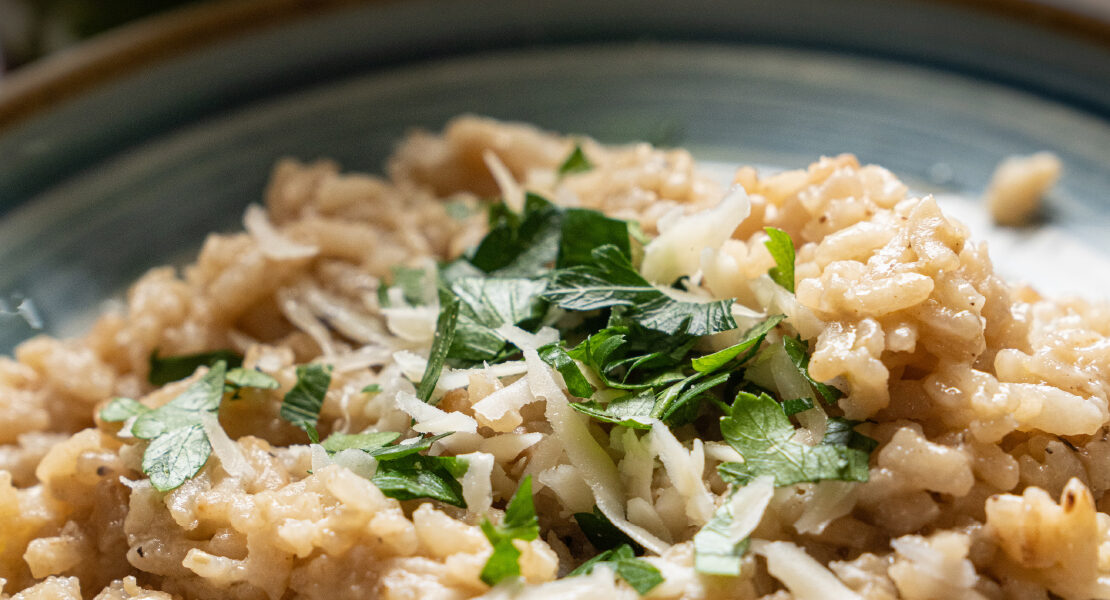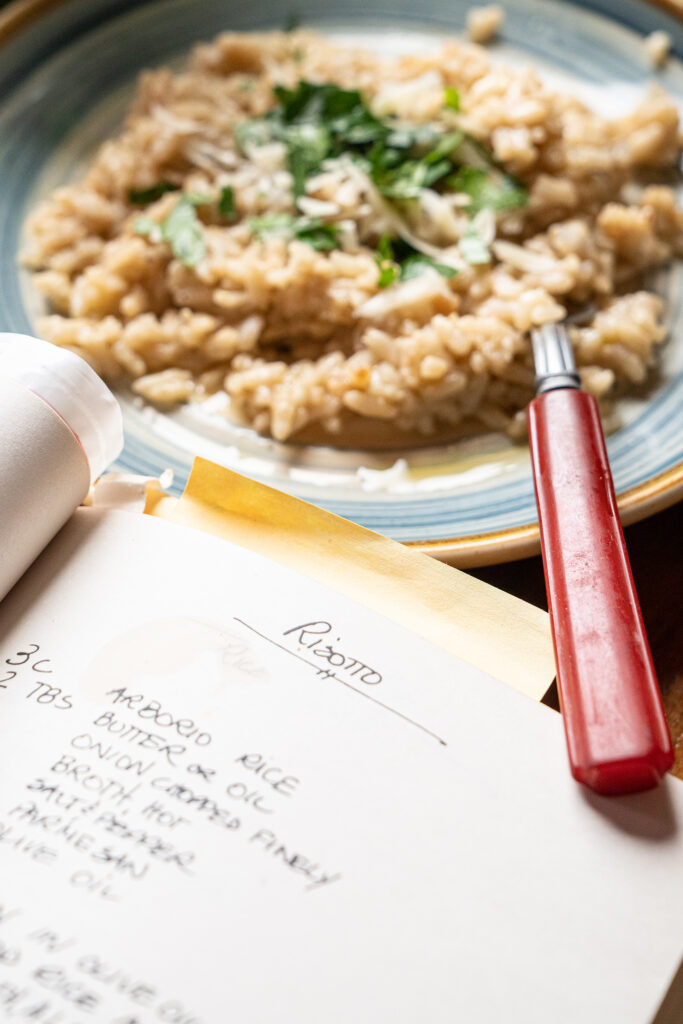Cooking 101: Risotto

A Stirring Experience
Lavishly creamy – without containing a drop of cream – and superbly comforting, risotto has been a classic Italian specialty for centuries. Although this dish finds a place on many contemporary American restaurant menus, a profound number of accomplished home cooks are intimidated by what they assume it to be difficult and intricate recipe. In fact, risotto is essentially just rice cooked in broth, with a mere handful of other ingredients. However, the technique and the type of rice used distinguish this delicacy.
Going with the grain
Starchy rice is essential for successful risotto. (That’s what creates the creaminess.) Arborio, a medium-grain rice, is always a good choice and can be found in most major grocery stores. Premium short-grain varieties of Italian rice such Carnaroli and Vialone Nano can be found in specialty shops and are best tried after perfecting your Arborio game. Avoid less starchy long-grain varieties such as Basmati and Jasmine.
Take the slow lane
The real secret ingredient in risotto is time. The cook will be spending about 20 minutes at the cooktop slowly stirring in broth, one ladleful at a time. Consider this a compact with the universe to never desert your post during the process: Ignore the phone, your partner, the kids, and the dog. Lehigh Valley Marketplace photographer Ryan Hulvat, who spent a college semester in Italy, took a cooking class while abroad and found time spent stirring risotto to be a “meditative experience.” Although current recipe versions that hasten the process – we’re looking at you, Instant Pot – and reduce stirring time are basically missing the point. Generations of busy Italian nonnas probably embraced having this undisturbed “me time” at the stove. Sipping a glass of wine can enhance the contemplative endeavor.
Details, details
The foundation of flavor comes from sweating chopped onions (or other alliums such as shallots, garlic, or leeks) in a pan with butter or oil. The rice is then added to the pan to toast briefly. What comes next, should you choose to include it, is a good splash of dry white wine which adds acidity to the dish and cooks off before incrementally adding the warmed broth or stock to the pan. This method allows the rice to gently shed starch as the stirring keeps them bumping together. The best way to tell when risotto is done is by tasting frequently during the last few minutes: The rice should have a toothsome bite and the sauce should be neither runny nor sticky. Should you run out of broth before the rice is done, simply use warm water as needed. Also, if a spoon dragged across the bottom of the pan leaves a trough that fills in gradually like flowing lava, that’s another indication that the risotto is ready for a bit of butter and hand grated Parmesan.
Tweak the taste
Risotto may be adapted for the season with such additions as fresh peas or asparagus in spring or butternut squash or porcini mushrooms in winter. Serve as a stand-alone first course or complement with proteins for a main course. Grilled shrimp or scallops are outstanding partners, and anyone who’s watched Hulu’s food-centric show The Bear knows that braised short ribs of beef served with risotto is a praise-worthy combo. Presenting risotto on an oven-heated plate is highly recommended: Starch-based sauces thicken as they cool, and preserving the luscious texture of this sumptuous dish is paramount for pleasure.
Tips
-Don’t rinse the rice, which removes the required starch.
-Use a wooden spoon. A metal spoon can break the rice and make the dish mushy. And a wooden spoon doesn’t make an annoying scraping sound.
-Keep the stock warm. Stirring in cold stock will mess up the cooking process.
-Take a gentle, even approach to stirring. You’re not beating egg whites here!
-Turning the heat on high will not speed cooking process. The rice grains won’t cook properly and you’ll have a burnt pan of goopy risotto with crunchy rice.
-Reserve leftovers to make arancini, stuffed Sicilian rice balls rolled in breadcrumbs and fried until crisply golden. They are utterly irresistible as a snack or app.
Buy Local, Eat Global
Risotto alla Milanese, one of the most beloved versions of risotto, boasts an enticing golden glow acquired by the addition of saffron. The delicate red stigmata of the crocus flower impart a complex earthiness to savory dishes, baked goods and beverages. Although considered the world’s priciest spice, only a few threads deliver intense color and flavor – so a little goes a long way. With a mission to bring high quality and healthful imported saffron to American and Canadian audiences, Ali Almasi, a graduate of Lehigh University’s Technical Entrepreneurship program, founded his flagship brand Zaffrus (zaffrus.com) in Bethlehem in 2017. The website offers different styles of saffron, including organic and premium, and saffron-infused products. However you use it, saffron adds a touch of elegance.
 RISOTTO
RISOTTO
INGREDIENTS
6 cups broth (chicken or vegetable)
1 T olive oil
2 T + 2 T butter
1/2 medium onion, chopped finely
1/2 cup dry white wine (optional)
3 cups Aborio rice
Salt and freshly ground pepper
Handful of grated Parmesan
Olive oil for garnish (optional)
Grated Parmesan for garnish (optional)
Chopped flat leaf parsley (optional)
DIRECTIONS
Heat stock to a low boil in large saucepan; reduce to medium-low heat and keep warm. Warm olive oil and melt 2 tablespoons butter in a large, heavy-bottomed pan over medium heat. Add onion and sauté until translucent. Add rice and stir for about 2 minutes to coat the rice with the butter and oil. The rice should be lightly toasted, with a nutty aroma, but not browned. If using wine, stir it in briskly until wine is fully absorbed. Next, begin gently stirring in hot broth, one ladleful at a time. (At this point, a timer set for 15 to 18 minutes can help to make sure the process is on track.) Continue stirring and adding a ladleful of broth when the previous addition of liquid has been absorbed. Season with salt and pepper to taste. When the rice is cooked al dente, stir in the remaining 2 tablespoons of butter and handful of grated Parmesan. Plate and drizzle lightly with olive oil, and sprinkle with Parmesan and parsley as desired.
Variation:
RISOTTO ALLA MILANESE
Following the above directions to the step where the rice is toasted. At this point add wine along with 2 good pinches of saffron (about 0.25 gram), stirring briskly. When the wine cooks off and is fully absorbed, continue the process of stirring in 1 ladleful of stock at a time as described above.
Yield varies by portion size (and how much you wish to reserve for making arancini)
Adapted from Mangia Firenze: The Art of Eating & Cooking Italian by Judy Witts Francini, the instructor at the cooking school Ryan Hulvat attended in Italy.










